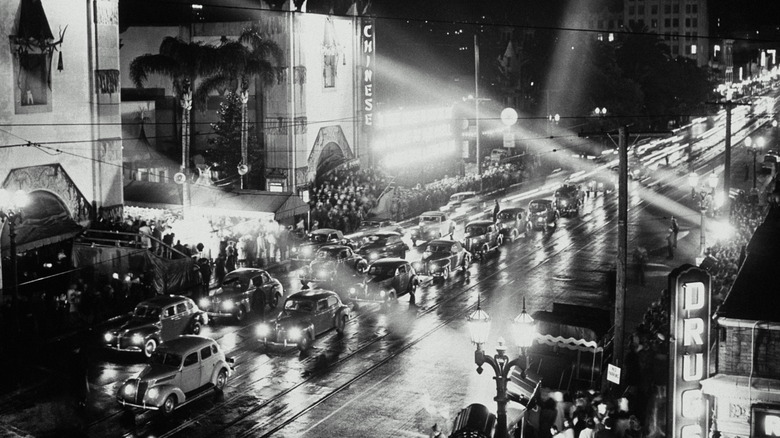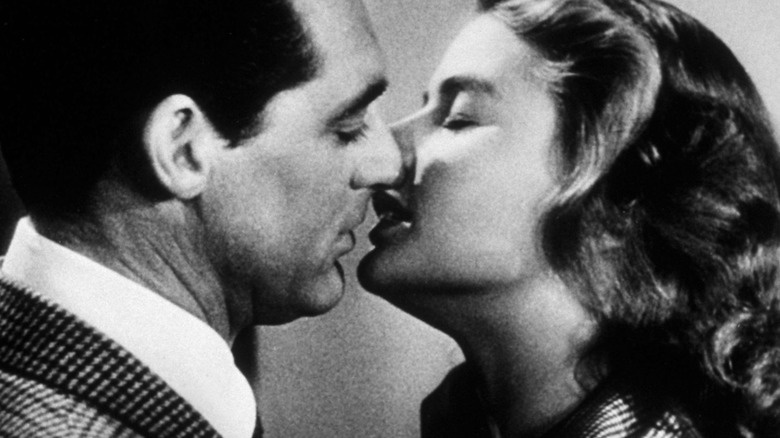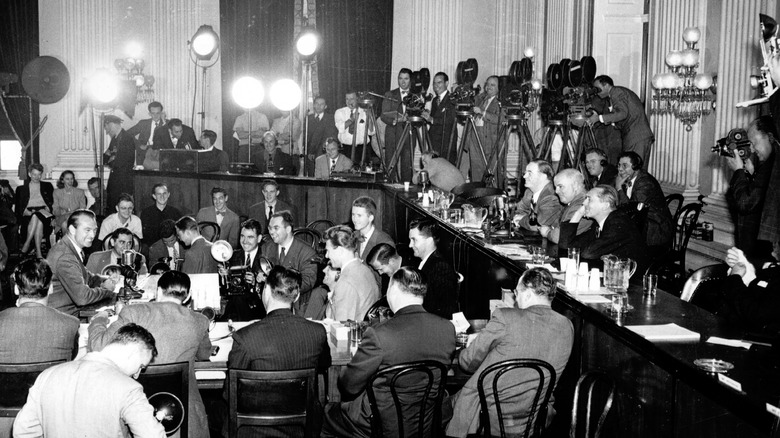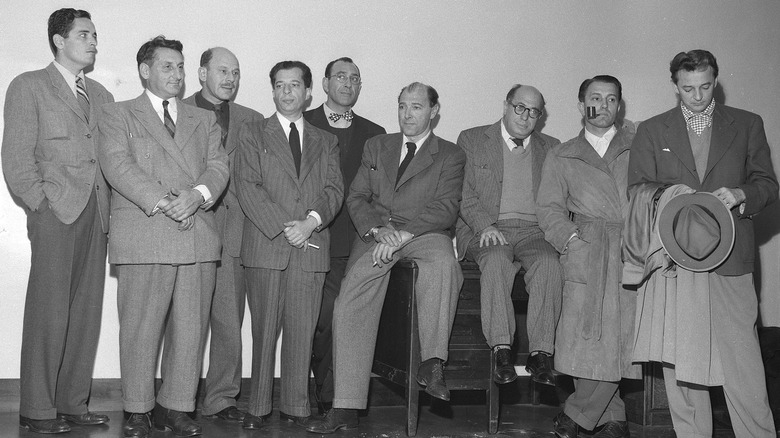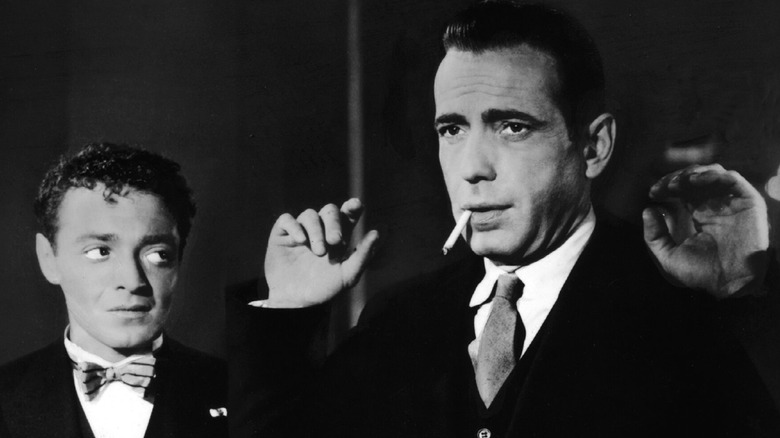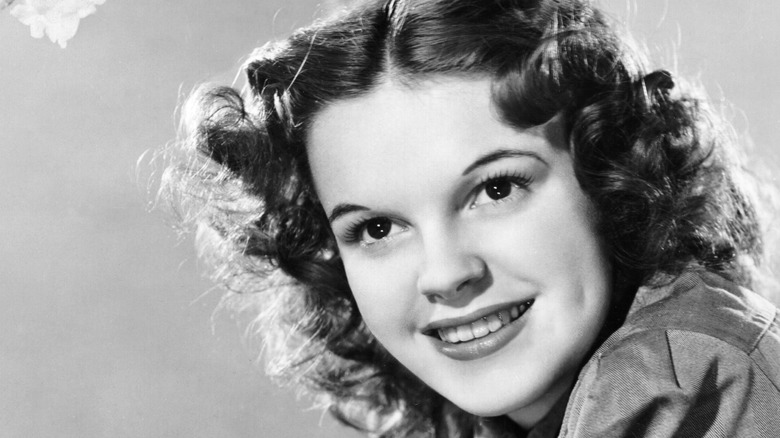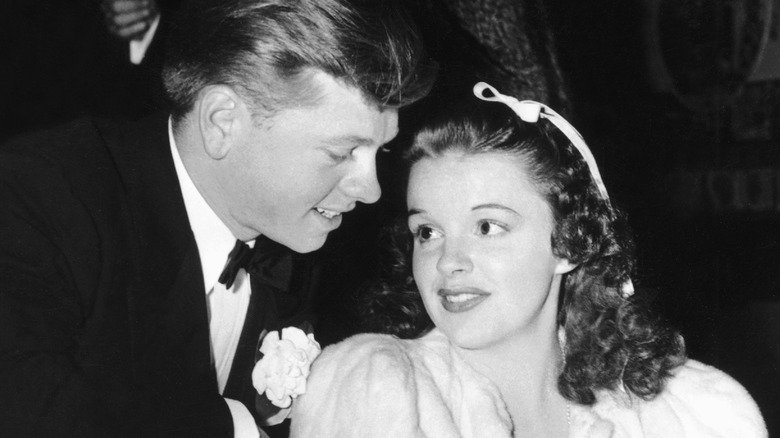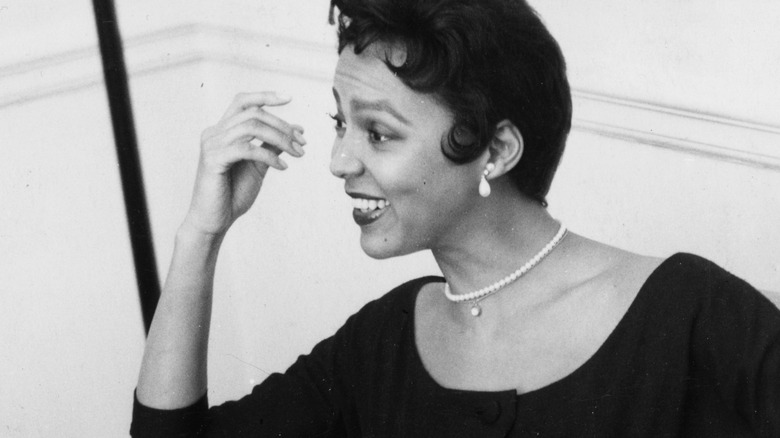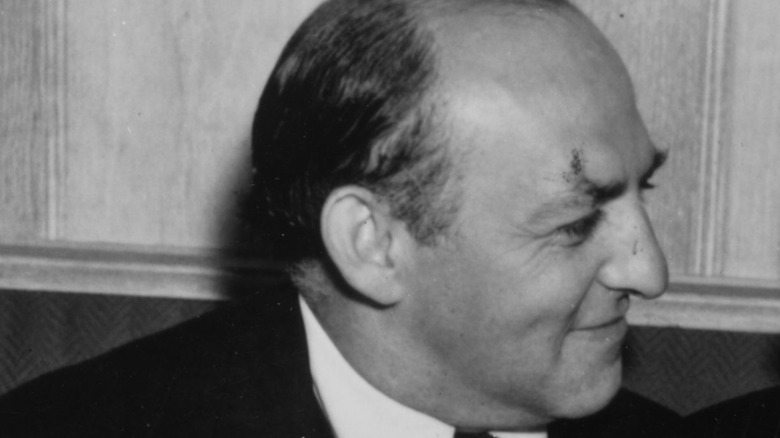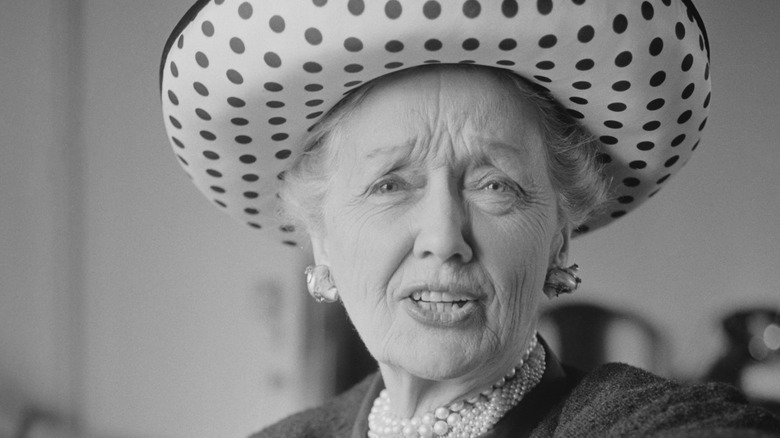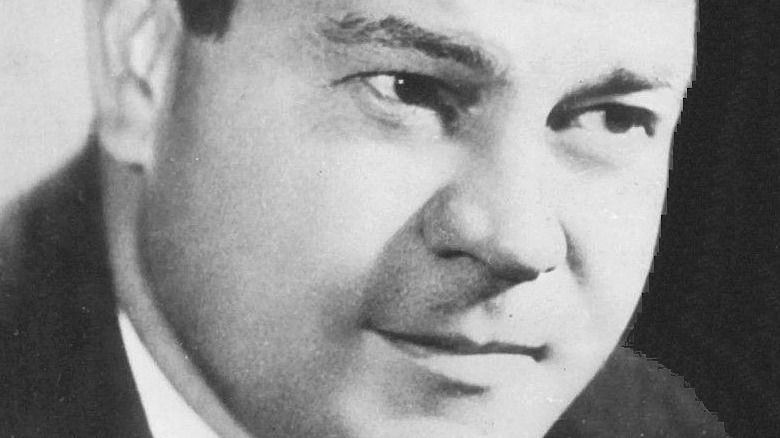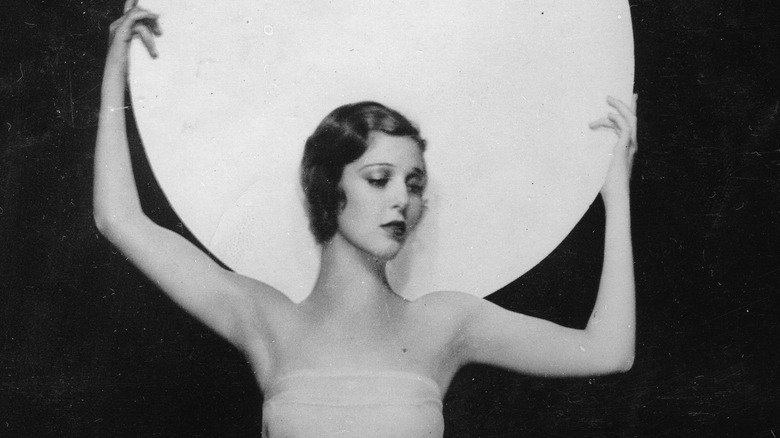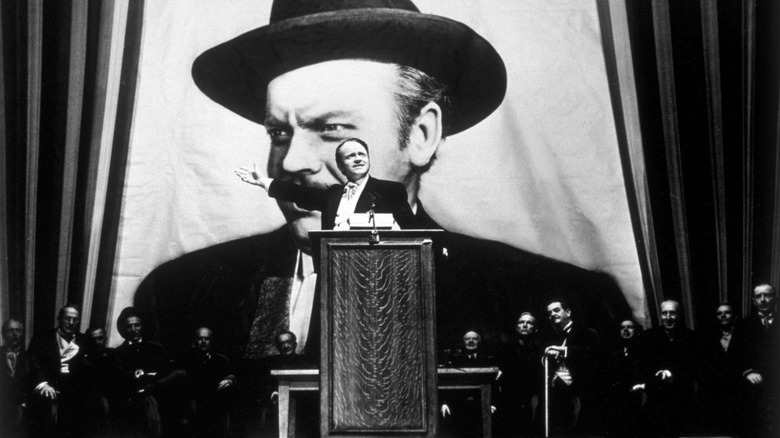Hollywood's Blacklist Era: The Dark Side Of 1940s Entertainment
The 1940s were a time of enormous change in the film industry. Often referred to as a part of Hollywood's Golden Age, the 1940s saw the release of films like "Citizen Kane" and "Casablanca" that would become classics. Stars like Jimmy Stewart, Cary Grant, and Humphrey Bogart appeared on the silver screen with icons like Katherine Hepburn, Vivien Leigh, and Veronica Lake. Behind the glamorous facade, however, Hollywood could be a cruel and violent place.
Within Hollywood, America's favorite stars were tightly controlled by film studios, and their executives worked overtime to ensure that no unsavory stories about their actors appeared in the gossip columns. Aspiring performers and beloved stars alike worked long, hard hours to make movies, often facing discrimination and harassment. From outside Hollywood, international politics created a tense environment and filmmakers faced censorship due to their political views — or rumors about their political views. Toward the end of the decade, accusations that some harbored communist sympathies destroyed careers and landed people on the infamous blacklist.
The Hays Code was self-imposed censorship
In the 1920s, Hollywood was seen as a debauched place full of loose morals, drug use, and crime. Films were widely seen as promoting heightened sexuality and violence, and for a while, it seemed like the government might actually step in and force censorship on Hollywood. To avoid this, the film industry censored itself. The studios began following The Production Code of the Motion Picture Industry, often called the Hays Code. These moral standards officially remained in place until 1968, limiting what American films could show.
The code's standards reflected the morality of the time, forbidding both overt and subtle sexuality, with bans on everything from nudity to kissing for too long. Religion could not be criticized, the characters could not drink too much, and no relationships between characters of different races could be depicted. It also was used to prevent films with political messages from being made if they were considered subversive.
By the 1940s, foreign films, which didn't have to follow the code, were more popular than American films. To compete, Hollywood filmmakers were pushing the limits of the code and finding ways to tell darker stories without getting censored, particularly in film noir. Still, as described in James Naremore's "More than Night: Film Noir and its Contexts," changes often had to be made to scripts in order to get them approved, sometimes forcing moralistic endings onto complex films.
Actors were blacklisted during the Red Scare
Since 1918, there had been fears that Hollywood had communist sympathies — eventually prompting Hollywood to start making big-budget propaganda films preaching the evils of communism in the late 1940s. As noted by Jstor Daily, these films were not particularly successful with audiences, but behind the scenes, a massive purge was going on in Hollywood, and any filmmakers or actors seen as not being patriotic enough were forced out of the industry. This hysteria over the threat of secret communist agents working within Hollywood would continue throughout the 1950s.
In 1947, The House Un-American Activities Committee (HUAC) questioned studio executives, directors, and movie stars alike to see if any might have had links to communism. Under pressure from the U.S. government, movie studios created a "blacklist," or list of people who would no longer be hired to work in Hollywood because they were considered communist sympathizers or radicals. This list included some of the greatest directors, writers, composers, and performers to ever work in film, including Orson Welles, Arthur Miller, and Dashiell Hammett.
Naming names was considered patriotic
In 1947, the House Un-American Activities Committee (HUAC) summoned 41 prominent members of the film industry to be questioned about possible communist sympathies. They were ordered to officially declare whether or not they had ever been a communist, and if they had been, they were expected to give up the names of anyone else they knew of who had also been a communist. By accusing others of being communists, these informants were able to (somewhat) clear their own names and potentially keep themselves off the blacklist. But in doing so, they put the careers, livelihoods, and even the freedom of others at risk. At the time, it was seen as a patriotic thing to do. Journalist Victor Navasky (via The Chicago History Museum) described this "informer principle" as making "the test of citizenship ... your willingness to betray friendship."
Fighting back could mean the end of a person's career or worse. Famously, 10 of the people summoned before HUAC refused to answer the committee's questions or name names, describing it as a violation of their First Amendment rights. All 10 were fired from their jobs in the film industry, blacklisted, fined, and sentenced to more than six months in federal prison.
|Photo by Los Angeles Times photographic archive/UCLA Library via Wikimedia Commons|Cropped and scaled|CC BY 4.0|
Film noir reflected the darkness of the era
As the United States came out of the Great Depression, only to be plunged into World War II, Americans were plagued by fears of communism and nuclear war. This atmosphere forged a genre to define the decade: film noir. These were gritty crime movies with existentialist messages, starring disillusioned heroes in starkly lit alleyways. Film noir tested the censorship that was prevalent at the time, having to find ways around the Production Code to tell their grim stories. Though, as described in "More than Night," some of the decade's most beloved films in the genre were still censored. "The Maltese Falcon," for example, was forced to eliminate references to sex, tone down the implication that one of the characters was gay, and completely remove a section critical of district attorneys.
Film noir didn't just reflect the darkness of the time, it commented on it. Famous director Elia Kazan's film "On the Waterfront" depicts a character who can be described as a noble snitch, turning people into the police. As noted by the Los Angeles Times, this is widely believed to have been a defense of Kazan's own decision to name names.
Meanwhile, the influential film noir masterpiece "Rififi" depicts a criminal who caused his fellow conspirators to be exposed, and who is brutally murdered by his former friends for giving them away. "Rififi" was directed by Jules Dassin while he was exiled in France, having been blacklisted by Hollywood.
Stars had no privacy from the studios
The 1940s are remembered for the era's glamorous stars, but behind the scenes, those stars were frequently controlled by studios who spied on them, manipulated them, and controlled their personal lives.
Many studio executives are believed to have spied on their stars in order to keep them in line. As noted by Turner Classic Movies, Columbia Pictures president Harry Cohn was believed to have bugged dressing rooms and sets in order to listen in on the cast and crew. Some went even further. As described by Judy Garland (via Gerald Clarke's "Get Happy") producers would also hire people to pretend to become friends with their stars, while secretly reporting everything they did to their bosses back at the studio. According to Garland, this happened to her and her co-star Mickey Rooney.
Along with hiring fake friends to spy on them, there is reason to believe that the studios sometimes pushed their stars into fake marriages. Studio contracts could be notoriously ironclad, and like today, often included morality clauses that made failing to live up to the studio's moral standards a fireable offense. As described by History, being LGBTQ+ was considered unacceptable under these terms, and dating back to the 1920s, it is believed that studios would encourage their gay stars to form heterosexual marriages to conceal their real sexualities.
Working in Hollywood was grueling
Performers in the 1940s were expected to work incredibly long hours on set, even when it took a toll on their health. Even child stars were not exempt from these trying working conditions, despite the fact there were regulations in place that were supposed to protect them. Famously, Judy Garland described herself and Mickey Rooney as working for 72 hours straight on only 4 hours of sleep as children (quoted via History). They were forced to take stimulants so they could continue to have the energy to perform for so long. After their shift, they were given sleeping pills. In order to wake up, they would have to take the stimulants again.
Garland and many other women in Hollywood — including Marilyn Monroe and Joanna Moore — were given amphetamines to control their weight. And actors weren't the only ones using stimulants to keep up with the fast pace mandated by Hollywood studios. Directors and crew members on many film shoots, including "The Third Man" and "Gone with the Wind," regularly took amphetamines in order to get the work done.
Racial discrimination was still common in Hollywood
By the 1940s, it was becoming more common to see Black actors on screen. As noted by anthropologist Russell Leigh Sharman in "Moving Pictures," MGM released "Cabin in the Sky" in 1943, which had an entirely Black cast, including superstar Sidney Poitier and the glamorous Dorothy Dandridge. Despite the progress onscreen during the 1940s, however, Black actors still faced discrimination and bigotry behind the scenes.
As recounted in Donald Bogle's biography of Dandridge, there was still significant segregation in Hollywood. While there was no official rule, multiple Black performers of the era noted that there were sections of the cafeteria where they weren't supposed to sit, where their white co-stars ate. According to Black actors on the set of 1939's "Gone with the Wind," there were signs segregating the on-set bathrooms (until star Clark Gable complained). Famously, the movie's main Black star, Hattie McDaniel, is believed not to have been invited to the premiere.
In 1942, the iconic Lena Horne signed with MGM and became the first Black person to have a long-term studio contract. However, Horne has stated that the studio encouraged her to present herself as Latina rather than Black, and sometimes tried to change her skin tone with makeup. Although she was famous and beloved, Horne was often only cast to sing in films, rather than being given characters with dialogue, which eventually drove her out of the film industry altogether.
There was a culture of sexual harassment
Sexual violence was incredibly pervasive in the Golden Age of Hollywood. As described by History, dancers and extras were often advised not to go to parties, but these invitations were extremely difficult to decline. On at least one occasion, more than 100 women performers were tricked into attending what they were told was a night shoot, but turned out to be a party where they were the entertainment. Rape was a constant threat for women working in Hollywood and sexual harassment was the norm.
While extras were particularly vulnerable, many of the decade's biggest names also dealt with harassment throughout their careers. Rita Hayworth described being harassed by Colombia Pictures president Harry Cohn for decades, who planted listening devices in her dressing rooms, constantly asked for sexual favors, and used his position to punish her when she refused. Ginger Rogers also complained about Cohn, saying he once physically chased her.
Young stars were also at risk. In her unpublished autobiography (via Washington Post) Judy Garland said that as a teenager, she was regularly groped by producer Louis B. Mayer until she firmly told him to stop, which made Mayer start crying. In Shirley Temple's autobiography "Child Star," Temple wrote that when she was 12, Mayer intentionally left her alone with producer Arthur Freed, who exposed himself. Luckily, when Temple laughed at him, Freed became enraged and kicked her out of his office.
If you or anyone you know has been a victim of sexual assault, help is available. Visit the Rape, Abuse & Incest National Network website or contact RAINN's National Helpline at 1-800-656-HOPE (4673).
The press could be vicious
The private lives of Hollywood stars were fascinating to the American public — and that kind of fascination was valuable. Gossip columnists like Hedda Hopper (above) and Louella Parsons were feared in the film industry because they made their living by paying insiders for stories about the personal lives of stars and publishing them. Hopper was the most famous of the gossip columnists and became notorious for her many hats and many spies throughout Hollywood. Hopper published details of the personal lives of major stars, including Cary Grant, Katherine Hepburn, Spencer Tracy, and Charlie Chaplin.
While Hopper was feared and despised for her work profiting off of the private lives of others, she followed a unique and highly conservative moral compass of her own. As described by Donald Bogle in his biography of Dorothy Dandridge, Hopper was particularly offended by the idea of Dandridge having danced with a white man, and published a tirade against the idea of "intermixing." Hopper was also a staunch supporter of the Hollywood blacklists and worked to brand anyone with liberal politics as a dangerous communist influence.
The studios protected stars from consequences
Film stars were the biggest assets of Hollywood studios, so producers would go to extreme lengths to keep their stars' reputations clear and ensure their movies stayed profitable. Sometimes, that even meant covering up crimes.
As described by Slate, the role of general "fixer" was divided between two studio executives at MGM: Howard Strickling and Eddie Mannix. Strickling was officially the head of publicity, but a major part of his job was keeping the press from picking up stories he thought would hurt MGM's stars. Sometimes, this was achieved by planting alternate stories that targeted less valuable actors and actresses, or ones who worked at other studios.
Mannix, officially the comptroller and general manager for the studio, was responsible for bailing out some stars, intimidating others, reading their mail, and paying off witnesses. It is believed that Mannix was responsible for covering up sexual violence that occurred at studio parties, including the incident in which over 100 female performers were hired for a gig that turned out to be a trap. He is also believed to have helped conceal Greta Garbo's relationships with women and cover up Clark Gable's car crash.
Stars were not allowed to get pregnant
Hollywood studios viciously guarded their stars as their biggest assets. They could be incredibly controlling of the personal lives of the actors and actresses they employed and attempted to prevent anything that would damage their careers — including having children. As described in a report by Vanity Fair, studio executives believed that pregnancy was a threat to the careers and reputations of their stars. Contracts forbid actresses from getting pregnant outside of marriage, and some also forbid marriage altogether. Actresses who violated these terms could be fired, have their income cut off, and find themselves unemployable in the film industry.
If they did become pregnant, on purpose or by accident, actresses were often strongly encouraged to have abortions, whether they wanted them or not. In the 1930s and 1940s, abortion was illegal, but the studios would arrange for the procedures. MGM's Howard Strickling and Eddie Mannix are believed to have arranged abortions for numerous actresses, as well as for the lovers of their male stars.
Many of the era's biggest stars, including Judy Garland and Dorothy Dandridge, were ordered to have abortions for the sake of their career. Loretta Young (above), who became pregnant after what is now believed to have been an assault by Clark Gable, was only able to keep her child by giving her up for adoption and then adopting her again several months later, keeping the fact that she was the child's birth mother a secret.
The political environment was weaponized against controversial artists
The highly controlling nature of Golden Age Hollywood paired with the volatile political environment of the 1940s created a world where the political beliefs or personal lives of filmmakers and actors could be weaponized to silence them. While "Citizen Kane" is widely regarded as the greatest film of all time, it was openly booed at the 1942 Academy Awards. The fact that it satirized the powerful William Randolph Hearst led to a vast campaign to destroy the film and its co-writer, director, and lead actor Orson Welles.
There were direct attacks on Welles, including attempts to frame him for crimes, but the true damage to his career would come in the form of blacklisting. As described by The Guardian, the campaign against Welles and "Citizen Kane" started with Hollywood's gossip columnists Hedda Hopper and Louella Parsons, who alerted Hearst to the film's content and began writing disparaging stories about Welles. Papers owned by Hearst began releasing stories that implied that Welles was a political radical and a communist. The attacks on Welles were effective, and the FBI declared that Welles was a threat to national security and that "Citizen Kane" was a communist plot to discredit Hearst.
